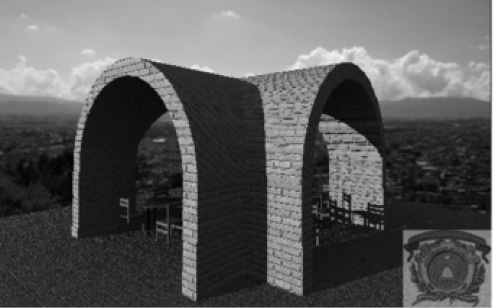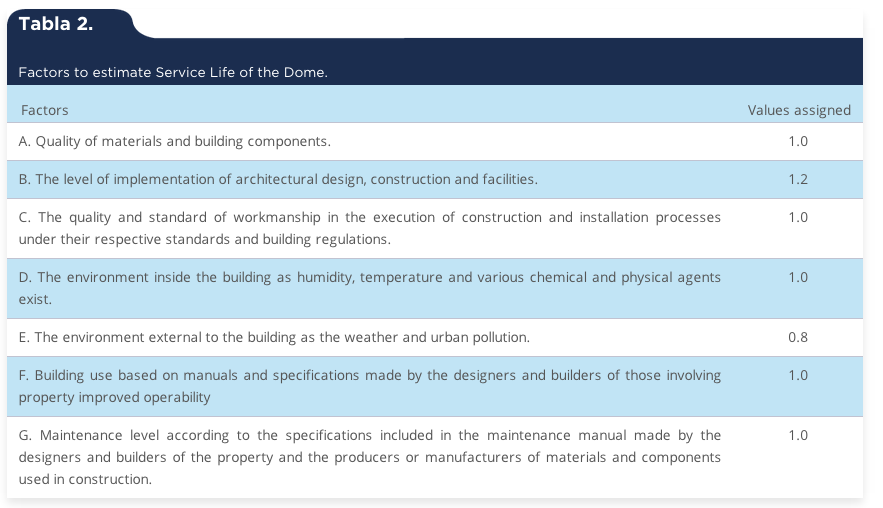METHODO
The most relevant factors that affect the durability of buildings based on the technical norm ISO 15686 “Buildings and constructed assets-service life planning” are:
A. Quality of construction materials and components;
B. The level and quality of architectural and construction design;
C. The quality and level of the workmanship in the execution of the processes of construction and installation, under the corresponding technical norms and construction regulations;
D. The environment inside the building, such as: humidity, temperature and diverse existing chemical and physical agents;
E. The environment surrounding the building, such as climate and urban pollution;
F. The use of the building according to manuals and specifications produced by the designers and builders, which turn into better operability of the building;
G. The degree or level of maintenance according to the specifications in the manual of maintenance produced by the designers and builders and those by the producers or manufacturers of the materials used in the construction.
As a matter of fact, the aforementioned facts are the factors that are evaluated in the method by factors, one of the main methods largely used to estimate the service life of construction materials and components (Architectural Institute of Japan [AIJ], 1993). ISO 15686 prescribes this method based on knowledge referring to materials and technology for construction. The method by factors estimates service life by means of a series of factors that are related to determinate conditions and specifications of utilization of the materials and components of the building. The formula to predict the estimated service life (ESL) by means of this method is:
ESL= RSL · A · B · C · D · E · F · G (1)
Where, RSL is the reference service life of a similar building or of any material or component of the building that could be taken as empirical information by the designer, from laboratory tests, from manuals and/or technical information from the product manufacturers (Masters & Brandt, 1989). RSL is only a starting point, as the key to estimate service life is performed by means of thoroughly assessing the aforementioned factors A, B, C, D, E, F and G. Therefore, the assessment of ESL according to the method by factors requires defining a single RSL as well as values for factors A to G. It is worth mentioning that this method by factors is not a predictive degradation model, but one based upon empirical information that can be utilized to plan service life having as reference specific information on the project (Lacasse & Sjöström, 2003). It can be considered that equation (1) contains all of the factors that play a role in the service life of a product; none of the technical norms ISO 15686 nor the Canadian CSA S478-95 (R2001) assign a constant value for each factor, but before applying the equation, the designer must explicitly assign the values of these factors, according to the particular conditions of the project. To do so, the designer must be knowledgeable on the quality of materials, construction systems, deterioration agents and everything related to the project as for design and construction. This method is not structured as a probabilistic method; however it shall be based on probabilistic characteristics of the internal and external characteristics which the construction materials and components are subjected to. Thereby the factors may vary according to different statistical distributions and so, the more experienced and knowledgeable the designer is the more successful the project will be (Moser, 1999).
Applying the methodology detailed in ISO 15686, specifically factor method for estimating the service life of a building and/or building components (ISO, 2000), the steps to apply are:
1. Identify the general conditions of service, type of building or constructed asset, functional and performance requirements of the building.
2. Determining the design life of the building and components.
3. Determine and identify the factors that affect the durability of the project.
4. Estimating the service life of the building and its building components (using the method ISO 15686).
Detailed explanation, development and its application of this methodology are described below.
Findings (Development and application of the method by factors for estimating service life in buildings)
The development and application (example) of the proposed method is as following:
Identify the general conditions of service, type of building, functional and performance requirements of the building.
A modernized adobe dome is a green building built, in this case constructed on the site, with regional materials, specifically common adobe1. Whereas the procedure of construction of the dome was developed in the city of Toluca, Mexico; it is advisable build it with adobe tech (stabilized with Portland cement and compacted mechanically) because Toluca’s climate is temperate-cold and adobe is a building material with excellent thermal conditions. See the image in figure 1 which illustrates an interior perspective of referred dome and in figure 2 an exterior perspective thereof. In this case, the construction bases are taken of “earth architecture” construction systems, which in conjunction with the current chemical technology, these form a solid structure, durable and geometrically correct (Minke, 2005), also using a special formwork during the construction process to give it an accurate result.
1 Pushkin, en Yévguieni Oniéguin, muestra ese egoísmo y sus consecuencias: “Son ceros para nosotros los demás / Y sólo nosotros los pocos elegidos. / Queremos todos volvernos Napoleones; / Y los millones de criaturas bípedas / Las consideramos si acaso, herramientas” (Pushkin, 1955).

Determining the design life of the dome
Continuing the procedure of the proposed method for estimating of service life and durability in buildings, it has a reference life of the dome, according to their conditions and estimated for median life, would be 49 years for this case (table 1). Then, it is observed that Design Service Life (DSL) of the dome is equal to DSL = 49 years, according to information from the Canadian technical standard CSA S478-9-R2001 (CSA, 2001) equivalent to ISO 15686 and the which also relies LEED® version of Canada, section: durability design (Canada Green Building Council [CaGBC], 2011) and information based on table 1 is described below. The following information (table 1) may also be useful at this stage 2 of the procedure, as it could guide us in determining a design life by component for categories of buildings for periods of time.
It is considered that table 1 is helpful for determining the design life as long as you respecting the use of the building to meet the design requirements and performance of the project (Hernández-Moreno, 2012). With reference service life or design life already determined, the next step concerns to determination of relevant factors that affect durability.
As regards the considerations of constructed asset failure (Talon, Boissier, Chevalier & Hans, 2004), these could raise if there is not a good maintenance planning, especially outside the dome finish at the junctions of bricks that serve as final finish, causing deterioration of the material and deterioration of the structure of the dome, causing damage on construction elements.
|
| |
 |
| |
Figura 1. Interior perspective of the Dome.
Source: Technology Development Project, UAEMEX; Academic group: Patrimonio, ambiente y tecnología, Toluca, Mexico, 2013. |
 |
Exterior perspective of the Dome.
Source: Technology Development Project, UAEMEX; Academic group: Patrimonio, ambiente y tecnología, Toluca, Mexico, 2013. Close |
|
| |
 |
| |
Figura 2. Exterior perspective of the Dome.
Source: Technology Development Project, UAEMEX; Academic group: Patrimonio, ambiente y tecnología, Toluca, Mexico, 2013. |
 |
Figura 2. Exterior perspective of the Dome.
Source: Technology Development Project, UAEMEX; Academic group: Patrimonio, ambiente y tecnología, Toluca, Mexico, 2013. Close |
Determine and identify the factors that affect the durability of the project.
To determine these factors is necessary to rely on the method by factors of ISO 15686 (ISO 2000). These factors were mentioned in section of method description.
Estimating the Service Life of the building (using method ISO 15686 by factors).
Using the factor method to calculate the ESL by correcting Design Service Life (DSL) or RSL, through the multiplication of the values of the factors in the range of 0.8, 1.0 and 1.2, using the equation:
ESL= DSL · A · B · C · D · E · F · G (2)
Where ESL is the Estimated Service Life, DSL is the Design Service Life and A - G are the factors that affect the service life of the building components according to ISO 15686. After considering the factors, determining the values for each as the project indicates (table 2) according to the designer experience and to general service conditions observed, in this case, on the constructed asset (dome with adobe tech), as follows:
Values are substituted in the equation (1):
ESL= 50 (1) (1.2) (1) (1) (0.8) (1) (1)
ESL = 48 years.
Seen the resulting estimation of service life according to the technical standard ISO 15686 of the constructed asset concerned, hypothetically decreased slightly over design service life (50 to 48 years). This was resulted due mainly to environmental factors, particularly, due to the humidity conditions on the location, however, these environmental factors, on this site, are not really aggressive and do not significantly affect. As summary, it is considered that estimation, for this case of example, is acceptable, because the resulting value is not too away from the design service life value, and therefore is considered acceptable.
Tabla 1.
Design life of buildings by category.
|
|
Building category
|
Design service life by
category (in years)
|
Examples
|
|
Temporary
|
Up to 10
|
Non-permanent buildings, sales offices, temporary exhibition buildings, temporary buildings.
|
|
Median life
|
25-49
|
Most industrial buildings and most parking structures.
|
|
Long life
|
50-99
|
Most residential, commercial, office, health, education, parking.
|
|
Permanent
|
Over 100
|
Monumental buildings, heritage type buildings (museums, art galleries, general files, etc.).
|
Source: Canadian Standards Association, 2001. Abrir
Tabla 2.
Factors to estimate Service Life of the Dome.
|
|
Factors
|
Values assigned
|
|
A. Quality of materials and building components.
|
1.0
|
|
B. The level of implementation of architectural design, construction and facilities.
|
1.2
|
|
C. The quality and standard of workmanship in the execution of construction and installation processes under their respective standards and building regulations.
|
1.0
|
|
D. The environment inside the building as humidity, temperature and various chemical and physical agents exist.
|
1.0
|
|
E. The environment external to the building as the weather and urban pollution.
|
0.8
|
|
F. Building use based on manuals and specifications made by the designers and builders of those involving property improved operability
|
1.0
|
|
G. Maintenance level according to the specifications included in the maintenance manual made by the designers and builders of the property and the producers or manufacturers of materials and components used in construction.
|
1.0
|
Source: Authors own elaboration, based on the method by factors, ISO 15686 and based on general service conditions observed on the constructed asset. Abrir
 |
Source: Authors own elaboration, based on the method by factors, ISO 15686 and based on general service conditions observed on the constructed asset. Close |